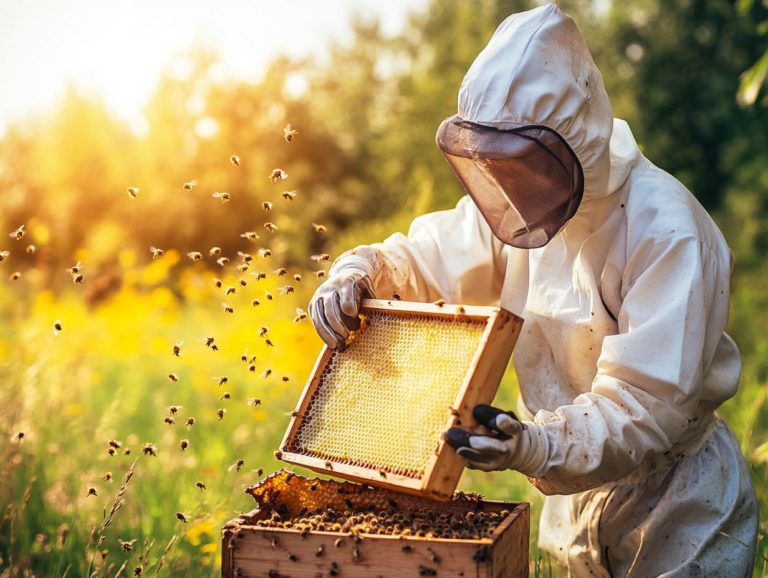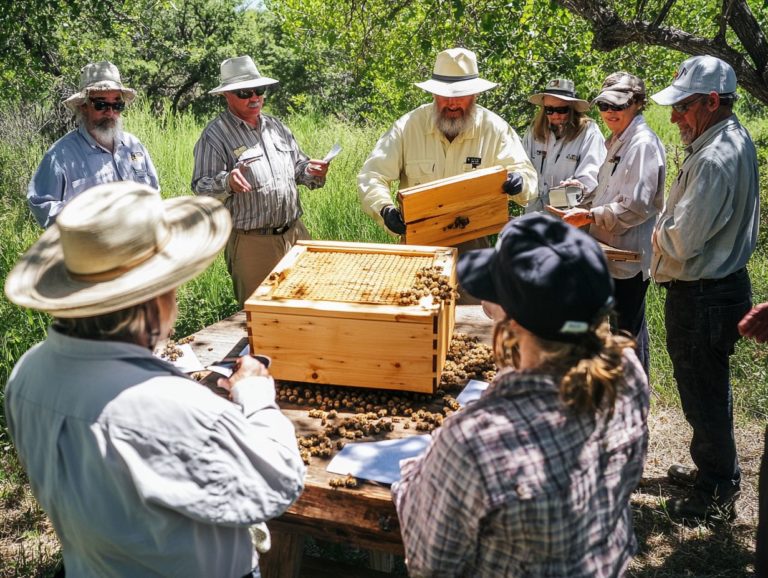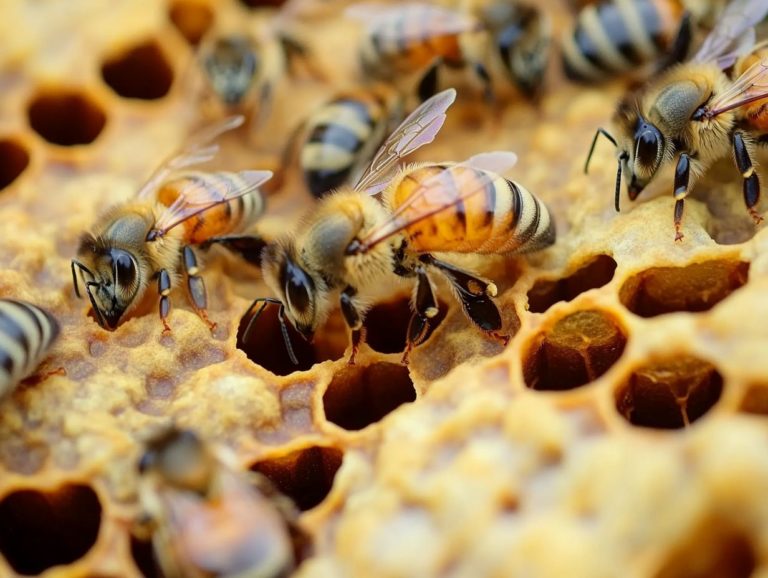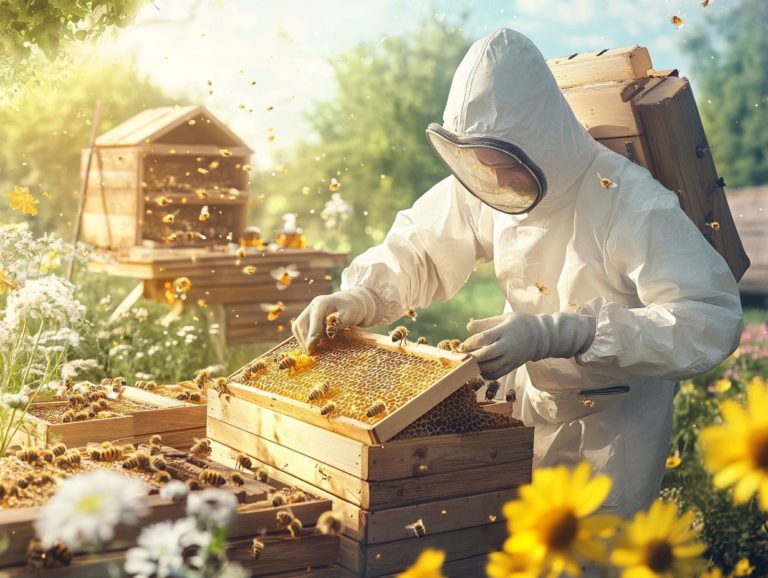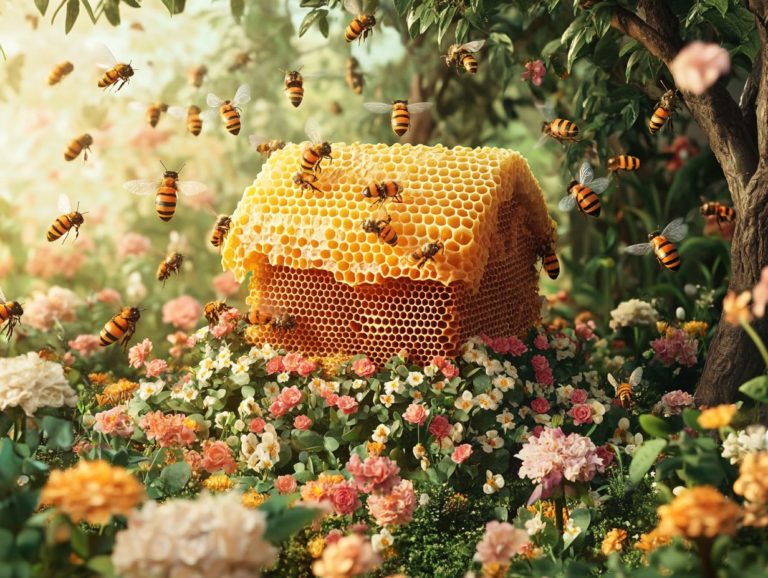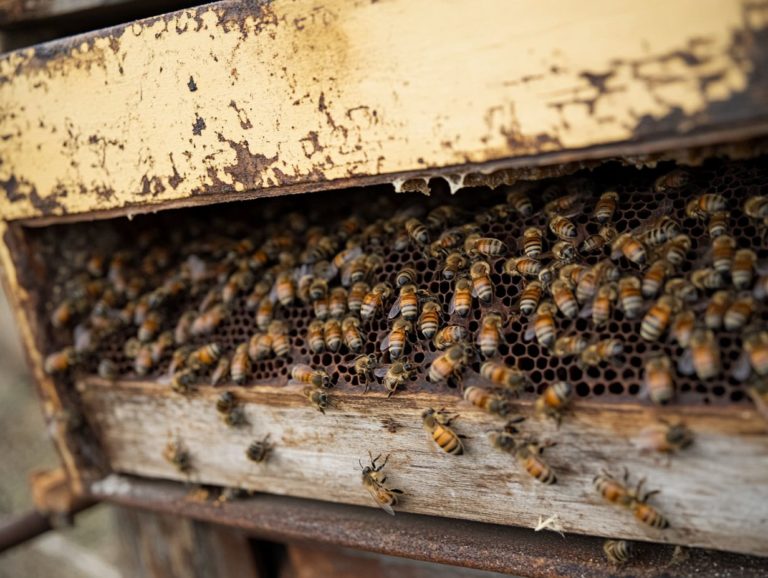How to Build a Better Hive
Beekeeping is an exciting journey that blends nature, science, and craftsmanship, captivating both beginner beekeepers and experts.
Understanding bee behavior and their needs is crucial for cultivating a thriving hive. This article explores the purpose of a hive, the factors that influence bee behavior, and the fundamental needs of these essential pollinators.
You will discover different hive types, essential materials, and tools necessary for building your hive, along with a comprehensive step-by-step construction guide. You will also find valuable maintenance tips, including using an entrance reducer, to ensure your hive remains healthy and productive.
Join the adventure of beekeeping, including DIY beehive projects, where both you and your bees can truly flourish.
Contents
- Key Takeaways:
- Understanding Bee Behavior and Needs
- Types of Hives
- Materials and Tools Needed for Hive Building
- Step-by-Step Guide to Building a Hive
- Tips for Maintaining a Healthy Hive
- Frequently Asked Questions
- What materials do I need to build a better hive?
- What are the important factors to consider when building a better hive?
- How can I ensure a safe and secure hive for my bees?
- What are some common mistakes to avoid when building a hive?
- Do I need any special tools to build a better hive?
- Can I customize my hive design to suit my specific needs?
Key Takeaways:
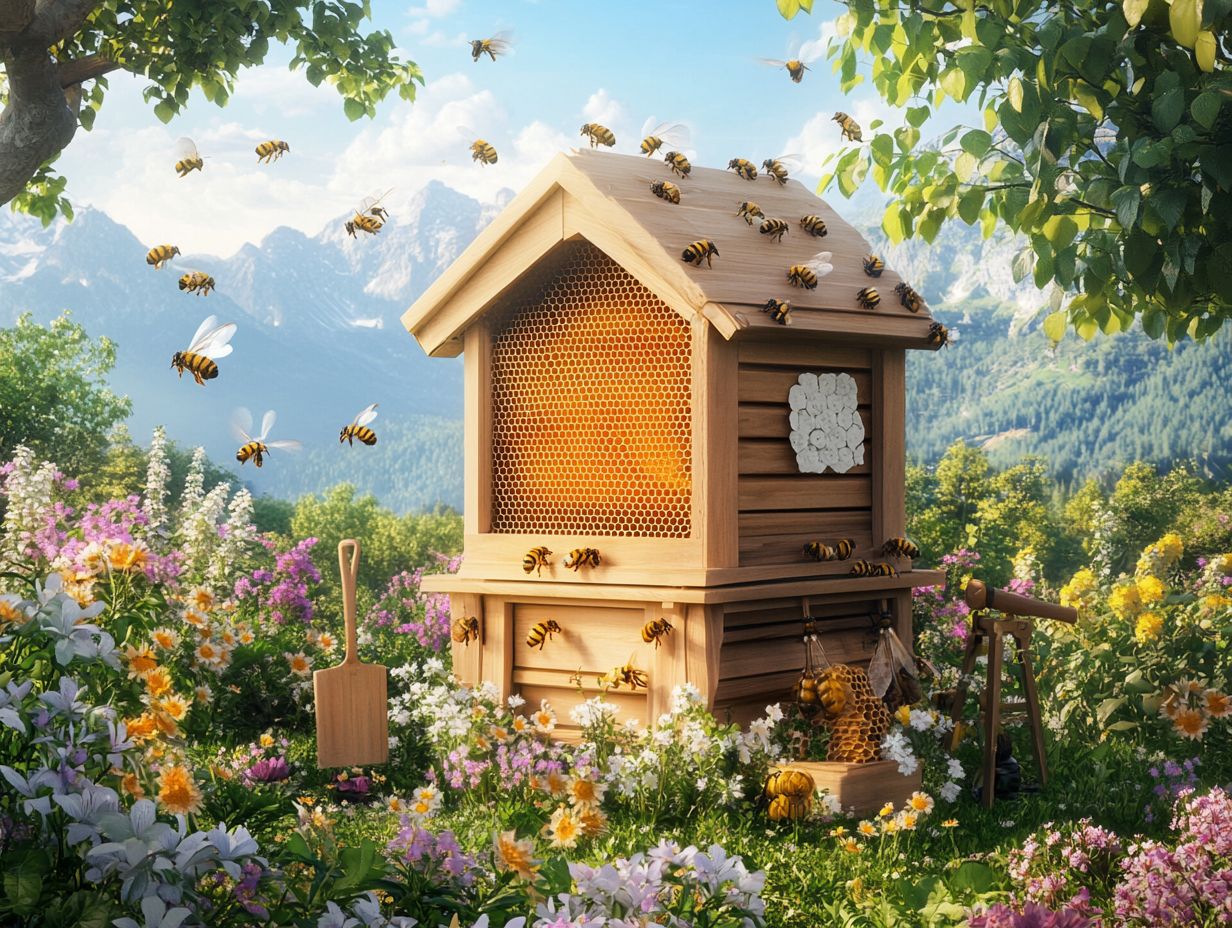
- Understanding bee behavior and needs is essential for building a successful hive. Consider factors that affect their behavior and provide for their basic needs.
- Choose from various types of hives, such as Langstroth, Top Bar, Warre, or Observation, based on your preferences and beekeeping goals.
- Select durable wood like cypress, pine, or cedar for building your hive. Gather necessary tools and materials, such as wood glue, wood dowels, and construction adhesive. Follow step-by-step instructions for constructing and maintaining a healthy hive.
Understanding Bee Behavior and Needs
Understanding bee behavior and their needs is essential for your success in beekeeping, especially if you’re a novice looking to set up your first apiary (a place where beehives are kept). Bees play a vital role in the pollination process, which is crucial for many plants and crops. They also significantly contribute to honey production and support sustainable ecosystems.
To cultivate a thriving hive, it’s important to know the details about how bees act. This includes their communication, foraging habits, and the environmental factors that affect their well-being. By creating a supportive environment for these remarkable pollinators, you can enhance honey yields, promote biodiversity, and positively impact environmental protection efforts.
What is the Purpose of a Hive?
The primary purpose of a hive, like the well-known Langstroth beehive, is to provide a safe and structured haven for bees, ensuring optimal honey production and efficient hive maintenance.
These hives serve multiple important functions: they offer shelter from the elements, create spaces for honey storage, and provide a breeding area for the queen to lay her eggs. Additionally, components like the bottom board and queen excluder are crucial for maintaining hive order and productivity.
The design of the Langstroth beehive, with its stackable boxes and removable frames, is especially beneficial for novice beekeepers. This structure simplifies hive inspections and fosters a clean, organized space that allows for easy monitoring of colony health.
By maintaining the right conditions within the hive, you can effectively nurture the growth of your bee population, ultimately leading to a more bountiful honey harvest.
What Factors Affect Bee Behavior?
Several factors influence your bees behavior, including environmental conditions, hive maintenance practices, and the availability of food sources. Each of these elements is critical for your success in beekeeping and honey production.
The weather, for example, plays a significant role; temperature fluctuations can affect the foraging habits of your bees, potentially leading to reduced honey yields if conditions are not ideal. Seasonal changes also impact pollination patterns, which directly influence honey harvesting outcomes. These changes dictate when blooms occur, either enhancing or restricting the food supply available to your bees.
Proper hive ventilation is essential; it helps maintain an optimal internal climate, preventing overheating or moisture buildup both of which can harm bee health. Therefore, you must stay vigilant about the conditions inside your hives to create a thriving environment that encourages robust honey production and ensures the overall well-being of your colony.
Start your beekeeping journey today for a chance to harvest your own honey!
What Are the Basic Needs of Bees?
The essential needs of bees include access to nutritious food sources, suitable housing, and favorable environmental conditions that support their health and productivity. These elements are vital for effective beekeeping.
To truly thrive, bees need an abundance of nectar and pollen, which are their primary sources of energy and nutrition. Using beehive parts like an inner cover and outer cover provides protection and ventilation. A well-structured hive that offers adequate ventilation and protection from pests is crucial for the safety and productivity of the colony.
By maintaining a clean and balanced environment, you can help bolster the bees’ resilience against diseases and environmental stressors.
Embracing sustainable beekeeping practices is key to fulfilling these needs. Such practices not only support bee populations but also enhance overall biodiversity and ecological health. By prioritizing the well-being of bees, you can significantly improve pollination services that are essential for both crops and wild plants.
Types of Hives
As a beekeeper, you have a selection of hive types at your disposal, each crafted to meet the unique needs of your bees while aligning with your personal preferences. Among these options, you’ll find the popular Langstroth beehive, the innovative top bar hive, the charming Warre hive, and the enlightening observation hive.
Each type offers unique benefits, whether you prioritize honey production, sustainable beekeeping, or a closer observation of bee behavior. This variety allows you to tailor your beekeeping experience to suit your philosophy and the well-being of your honeybees.
1. Langstroth Hive
The Langstroth beehive is one of the most favored designs among beekeepers, and for good reason. Its ingenious use of vertical space, complete with hive parts that you can swap out easily, makes managing your apiary a smooth affair.
This structure not only allows for easy access to all components during your routine inspections and management but also lets you harvest honey with minimal disturbance to the colony. Each frame can be individually removed, making it simple to examine the bee population a feature that caters to both novice and experienced beekeepers alike.
The use of honey supers, or extra boxes for storing honey, alongside interchangeable hive parts enhances the flexibility and efficiency of hive management. The hive’s modular design, which lets you add or remove parts based on your bees’ needs, offers you the flexibility to expand or contract your setup according to your colony’s needs, promoting optimal health and productivity.
It s little wonder that many beginners opt for this design as their gateway into the enriching world of beekeeping.
2. Top Bar Hive
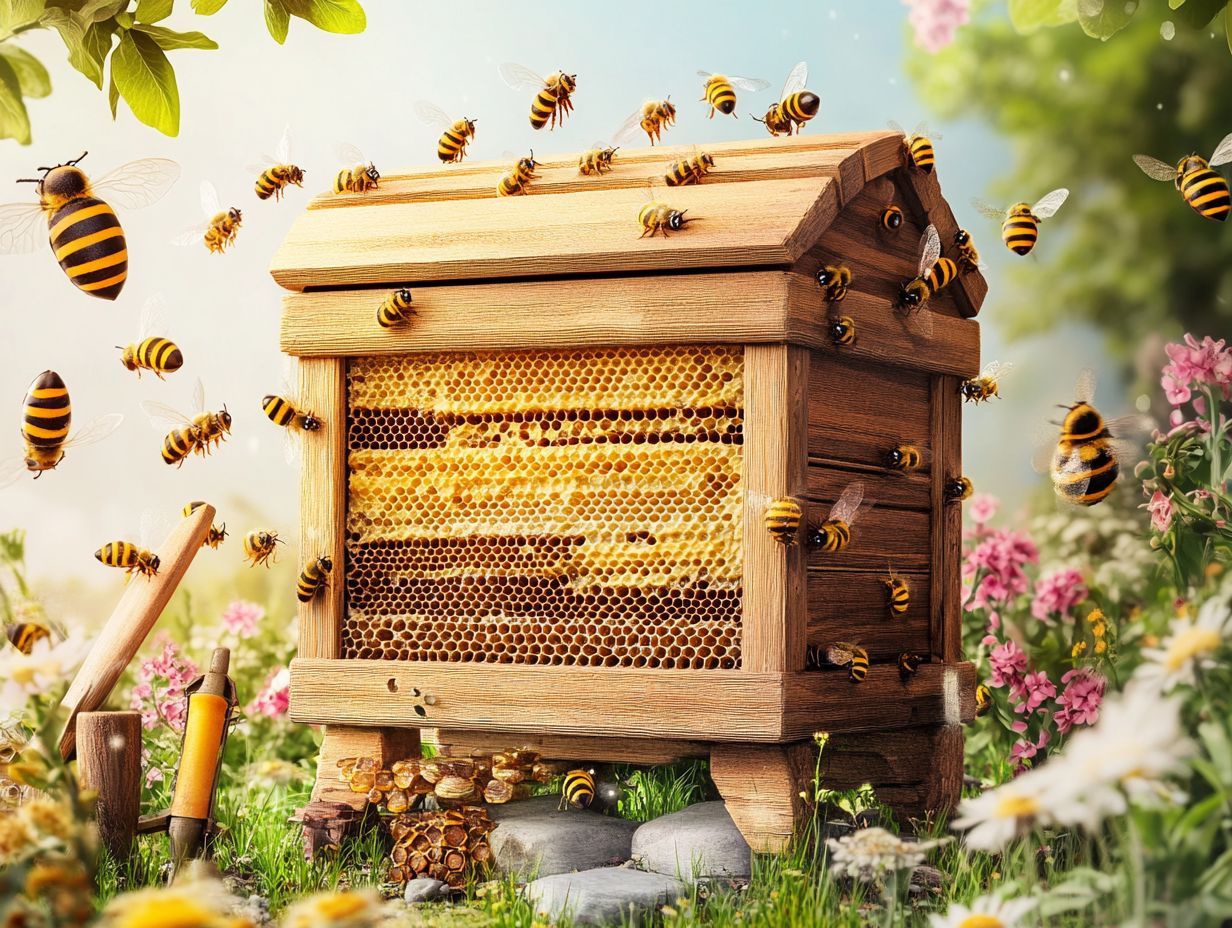
The top bar hive design is a favorite among novice beekeepers for its straightforwardness and user-friendly approach. It allows you to let your bees build their comb directly from the top bars, eliminating the need for pre-formed frames. This method fosters a more natural comb-building journey, encouraging your bees to follow their instincts.
By removing foundation frames, you promote better bee health and support the development of stronger colonies. However, consider the trade-offs: while natural comb can enhance your bees resilience, it may result in irregular sizes that could complicate honey harvesting.
For those embarking on their beekeeping journey, setting up a top bar hive involves a few key steps:
- Ensuring proper ventilation
- Placing the hive in a sunny spot
- Regularly inspecting for pests
- Using untreated lumber or second-hand wood for hive construction
Consistent maintenance is crucial, too. Keep your hive thriving by consistently checking moisture levels and ensuring there s enough space as your colony grows!
3. Warre Hive
The Warre hive encourages natural beekeeping practices with minimal intervention. This aligns perfectly with your commitment to sustainable beekeeping.
Its unique vertical design mirrors the bees’ natural habitat. This allows them to establish colonies intuitively and securely. With this setup, bees can better regulate their temperature and humidity, which fosters more effective foraging and ultimately boosts their overall health.
Thanks to its minimal management requirements, you can support the colony s natural processes without introducing unnecessary stress. This method not only champions bee welfare but also supports environmental protection and biodiversity through sustainable practices.
4. Observation Hive
The observation hive is a remarkable beekeeping tool that invites you to closely observe hive behaviors and the daily activities of bees without causing them any disturbance.
You can see the hive s inner workings with this design, which is invaluable for anyone eager to deepen their understanding of how bees work and live together and social dynamics. As you watch the interactions among the queen, workers, and drones, you ll begin to grasp essential concepts such as hive dynamics, foraging patterns, and communication methods.
The educational benefits of an observation hive go beyond simple observation; it helps you connect deeply to the natural world, igniting your curiosity and promoting immersive learning experiences that can greatly enhance your beekeeping skills. This hands-on approach gives you the power to build confidence and knowledge, ultimately leading to more successful hive management.
Materials and Tools Needed for Hive Building
Building a beehive requires several key materials and tools. Commonly used wood types include untreated lumber, cypress, pine, cedar, spruce, and fir. For budget-friendly materials, consider second-hand wood or plywood.
Essential tools required for hive construction include wood glue, construction adhesive, wood dowels, and beehive parts like the bottom board, inner cover, and outer cover. Cinder blocks can be used for hive setup, providing a stable and elevated base for your hive. You may also need beeswax foundation for frame assembly and aluminum flashing for weatherproofing.
When choosing paint colors for your hive, opt for non-toxic and weather-resistant options to ensure longevity and safety for your bees. Proper wood treatment is crucial in protecting your hive from environmental stressors.
Gather these materials and start building your hive today!
What Type of Wood Should Be Used?
When you’re selecting wood for hive construction, it’s essential to choose the right types, such as untreated lumber, cypress, pine, cedar, spruce, or fir, to ensure durability and safety for your bees.
The wood you choose plays a vital role in both the structural integrity of the hive and its insulation properties, ultimately influencing its overall lifespan. Untreated lumber is a popular option due to its natural resistance to pests and wide availability, but it may not hold up against the elements as well as some hardwoods. Cypress and cedar are particularly prized for their natural oils that help prevent decay and ward off pests, making them excellent choices for long-lasting hives. While pine and fir can be more budget-friendly, they might require more regular maintenance to keep them in good shape.
It’s crucial to steer clear of treated wood, as those chemicals can be harmful, potentially jeopardizing the health of your bee colony and compromising the quality of the honey they produce.
What Tools Are Needed?
The successful assembly of a beehive relies on several essential tools, including hand saws, drills, and various fasteners. These are crucial for creating a well-constructed hive.
You will also find it beneficial to have a level on hand to ensure that each section of the hive is perfectly aligned. A tape measure is also necessary for precise measurements while cutting the wood.
Optional tools like a bee smoker can help calm the bees during assembly. Additionally, a hive tool is invaluable for prying apart frames during inspections.
As a beginner beekeeper, it s important to familiarize yourself with the function of each tool and practice handling them safely. Using the tools correctly makes the process smoother and creates a better environment for the bees once the hive is up and running.
What Other Materials Are Needed?
In addition to wood, several other materials are vital for establishing a complete beehive setup. This includes essential hive components like frames, beeswax foundation, wood glue, and a bottom board.
You will also need a Queen excluder, a tool that keeps the queen bee separate from the honey storage area, to streamline hive management.
The bottom board serves as the bedrock of your hive. It provides crucial support while facilitating ventilation and easy access for your bees. Frames are specifically crafted to hold the beeswax foundation, allowing the bees to construct their comb for honey storage and nurturing their young.
Beeswax foundation, often derived from natural beeswax, encourages the bees to build their comb in an organized manner, optimizing both space and resources. The Queen excluder is a critical element that allows you to harvest honey without the risk of contamination. Together, these materials enhance the hive’s efficiency and the sustainability of the bee colony, fostering healthy growth and productive honey production.
Step-by-Step Guide to Building a Hive
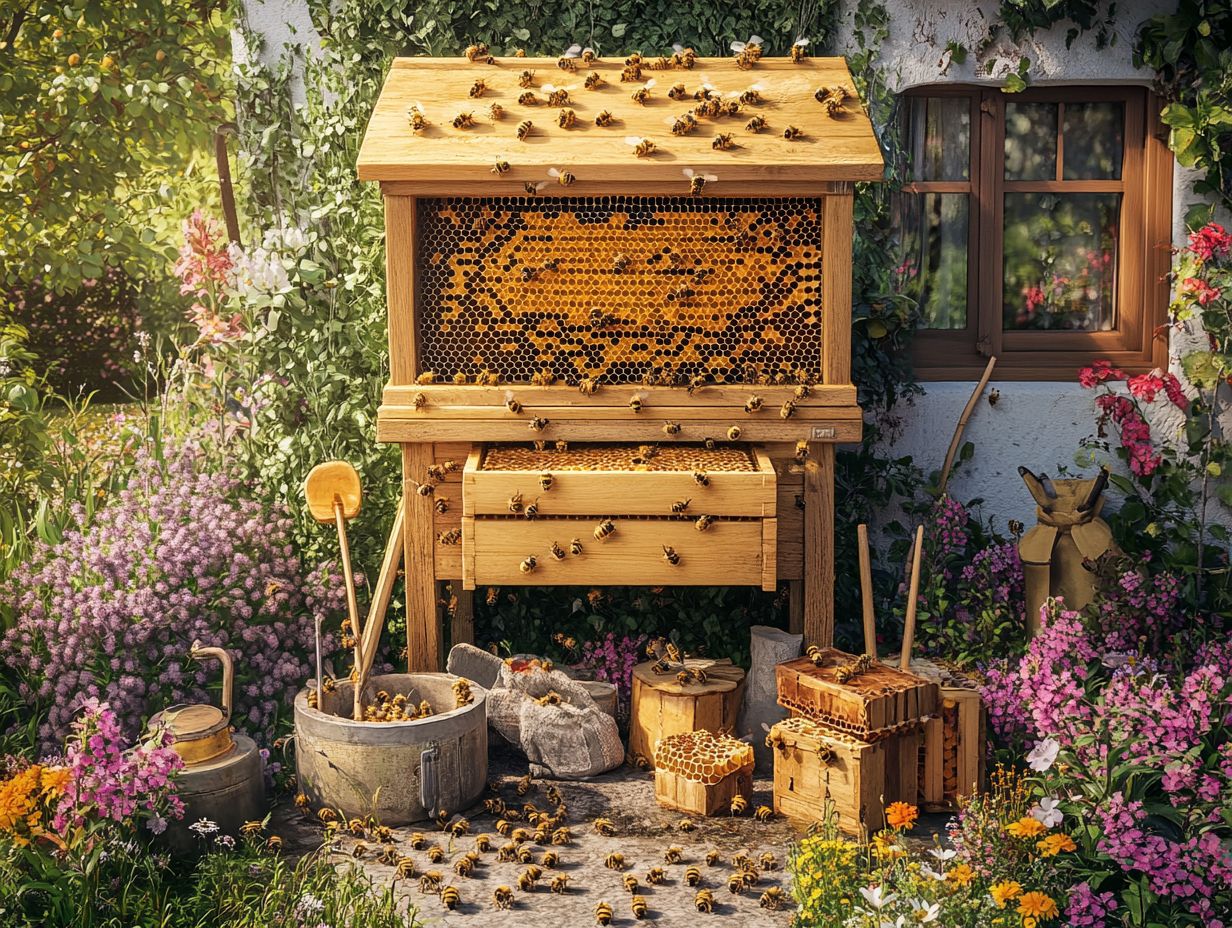
Building a DIY beehive involves clear steps that need careful planning. You will need to ensure proper frame assembly and adequate ventilation are crucial. Additionally, treat the wood for durability and the safety of your bees.
1. Preparing the Wood
Preparing the wood for your beehive begins with carefully selecting the right building materials. Apply suitable wood treatments to ensure durability and resistance against the elements. This initial step is vital, as the longevity of your beehive will largely hinge on the quality of the wood you choose.
When you’re in the material selection phase, opt for untreated cedar or pine. These woods are naturally resistant to rot and insects, making them excellent choices. After selecting your wood, treating it with natural oils or eco-friendly sealants will add an extra layer of protection against pests and weathering.
This careful preparation protects your bees and sets up a strong hive!
2. Cutting the Wood to Size
Cutting the wood to size is a pivotal step in building your beehive. It demands precise measurements and the right tools to ensure accurate cuts for each hive component.
To ensure that every piece fits together seamlessly, take careful measurements before making any cuts. Begin by gathering the necessary tools: a high-quality measuring tape, a square, and either a miter saw or a circular saw.
As you measure, use a sharp pencil to mark the wood, creating clear lines to minimize errors. Double-check your measurements and remember to use the square to confirm that all angles are precise. This meticulous attention to detail will help you achieve clean, straight cuts, laying the groundwork for a sturdy and well-constructed hive.
3. Assembling the Hive Boxes
As you assemble the hive boxes, connect the various parts with construction adhesive and wood glue to create a sturdy structure that can bravely withstand the elements.
Start by ensuring your workspace is clean and organized. This sets the stage for a smooth assembly process! Align the edges of the hive components before applying the adhesive to achieve that perfect fit. Don’t forget to use clamps while everything dries; they re your best friends in keeping everything in position and minimizing the risk of misalignments.
When assembling the frames, pay close attention to how they interlock and sit within the hive. This design is crucial for maintaining proper airflow and providing ample space for your bees to thrive. Ensuring that the frames are square and fit snugly enhances the hive’s stability and supports the overall health of the bee colony, making it easier for them to navigate and go about their busy lives.
4. Adding Frames and Foundation
Incorporating frames and beeswax foundation into your hive is essential for guiding the bees in their comb building the process where bees create honeycomb and honey production, greatly enhancing the overall efficiency of your hive setup.
These elements do more than just provide structure; they play a crucial role in emulating the natural environment where bees flourish. By offering a familiar framework, you encourage the bees to engage in their natural behaviors, such as constructing hexagonal cells for honey storage and brood rearing, optimizing space utilization within the hive.
When arranged thoughtfully, this setup can significantly boost your honey yields. Beekeepers often suggest positioning the frames with a slight gap between them to facilitate easy access and airflow. This arrangement allows the bees to move freely, promoting a productive and harmonious colony dynamic.
5. Adding a Roof and Inner Cover
The final step in constructing your hive involves adding a roof and an inner cover. These elements are essential for shielding the hive from the elements while ensuring proper ventilation for the health of your bees.
The roof is your first line of defense against harsh conditions like rain, snow, and intense sunlight, creating a stable internal environment where your bees can truly thrive. It s vital that the design keeps water out while allowing for sufficient airflow, which is key to regulating temperature and humidity within the hive.
The inner cover plays a similarly important role, offering your bees a buffer against temperature swings and drafts. By selecting materials that provide effective insulation while promoting airflow, you can significantly enhance the hive’s resilience, protecting the well-being of the colony and supporting their natural behaviors.
6. Painting and Finishing Touches
Painting and applying finishing touches to your beehive not only elevates its aesthetic charm but also offers essential wood treatment to shield it from the elements.
Selecting the right paint colors and finishes can truly transform an ordinary beehive into a delightful garden feature, all while ensuring the safety and well-being of your bees. Choosing non-toxic paint is crucial for your bees safety! It minimizes any potential harm to the colony, allowing your bees to thrive without any adverse effects. Opting for weather-resistant materials is equally important, as they help the beehive endure harsh conditions, from scorching sunlight to relentless rain.
For longevity, regular maintenance is highly recommended. Inspecting and refreshing the paint every couple of years will protect the structure and keep it looking attractive in your landscape. Plus, using lighter shades can reflect sunlight, helping to keep the interior cooler a thoughtful benefit for the bees inside!
Tips for Maintaining a Healthy Hive
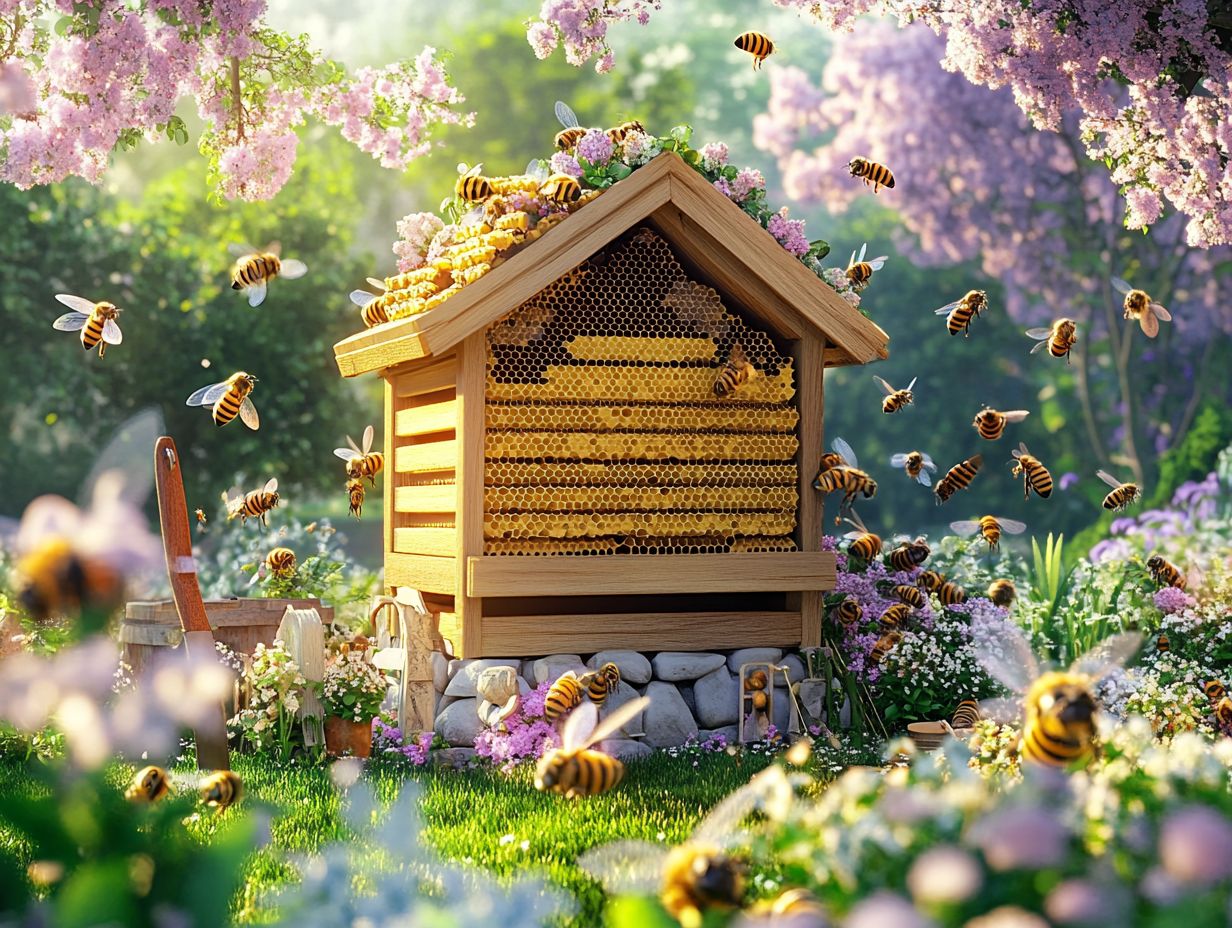
As a beginner beekeeper, maintaining a healthy hive is essential. It demands regular inspections and a solid understanding of the common pests and diseases that can jeopardize your bee colonies, especially during the critical honey harvesting periods.
Regular inspections are crucial! Catching problems early can save your colony!
How Often Should the Hive Be Inspected?
Regular inspections of your hive are essential for monitoring bee health and ensuring successful maintenance. As a beginner beekeeper, it’s wise to check your hives at least every two weeks during the active season. This schedule allows you to observe bee activity closely, providing valuable insights into how your colony is thriving.
During these inspections, pay close attention to any signs of pests or diseases, such as Varroa mites or foulbrood. These can significantly impact your hive s productivity. It’s crucial to ensure that the queen is healthy and actively laying eggs, as her well-being is vital for maintaining the strength of the colony.
When you conduct your inspections, be mindful of the weather. Warm afternoons offer the ideal conditions for your checks. Remember to handle your bees gently to minimize stress. Regular inspections not only promote the health of your bees but also elevate your experience as a beekeeper.
What Are Common Pests and Diseases to Watch Out For?
As a beekeeper, you need to stay alert to common pests and diseases that can threaten the health of your hives, such as Varroa mites, wax moths, and American foulbrood. Adopting sustainable beekeeping practices is essential for your success.
These threats undermine the physical strength of your bee colonies and can also significantly disrupt honey production. This results in lower yields and weakened hives. Take Varroa mites, for example they attach themselves to bees and feast on their bodily fluids, leading to deformities and increased susceptibility to other diseases. Wax moths can invade and wreak havoc on the hive’s structure, while American foulbrood is a serious bacterial infection that can wipe out entire colonies.
To effectively tackle these challenges, consider implementing management strategies such as:
- Regular hive inspections
- Using screened bottom boards
- Adopting integrated pest management (IPM) practices (a holistic approach combining various strategies for pest control)
These measures are crucial for maintaining a thriving beekeeping operation and ensuring the health of your bees.
Frequently Asked Questions
What materials do I need to build a better hive?
To build a better hive, you will need:
- A hive body
- Frames and foundation
- Inner and outer covers
- Entrance reducer
- Smoker
- Beekeeping suit and protective gear
- Hive tool
- Beeswax or propolis for sealing cracks
- Paint or stain for weatherproofing
What are the important factors to consider when building a better hive?
Some important factors to consider when building a better hive include:
- Proper ventilation and insulation to regulate temperature and humidity
- Placement of the hive in a sheltered area with access to sunlight
- Use of non-toxic materials for the health of the bees
- Appropriate size and design for the number of bees and honey production
- Accessibility for regular inspections and maintenance
How can I ensure a safe and secure hive for my bees?
To ensure a safe and secure hive for your bees, you should:
- Choose a strong and durable material for the hive body
- Use proper fasteners and joinery techniques to prevent gaps and weak points
- Regularly inspect and maintain the hive for any signs of damage or wear
- Keep the hive elevated off the ground to prevent flooding and pests
- Use entrance reducers to protect against intruders, such as mice or wasps
What are some common mistakes to avoid when building a hive?
Some common mistakes to avoid when building a hive include:
- Using toxic materials that can harm the bees or contaminate the honey
- Not providing enough ventilation, which can lead to mold and disease
- Placing the hive in direct sunlight or in an area prone to strong winds and harsh weather
- Using incorrect measurements or not following proper construction techniques
- Not regularly inspecting and maintaining the hive, which can lead to deterioration or pest infestations
Do I need any special tools to build a better hive?
In addition to basic woodworking tools, you may need some specialized tools to build a better hive, such as:
- A beekeeping smoker to calm the bees and make them easier to work with
- A hive tool to pry open and remove frames
- A wax or propolis scraper to clean and seal cracks
- A bee brush or fume board to remove bees from the frames for inspection
- A level to ensure the hive is properly positioned and balanced
Can I customize my hive design to suit my specific needs?
Absolutely! You can choose from various hive designs and styles.
Feel free to change it to fit your style and the needs of your bees. Do your research and ask experienced beekeepers for advice to create a successful and functional hive!

